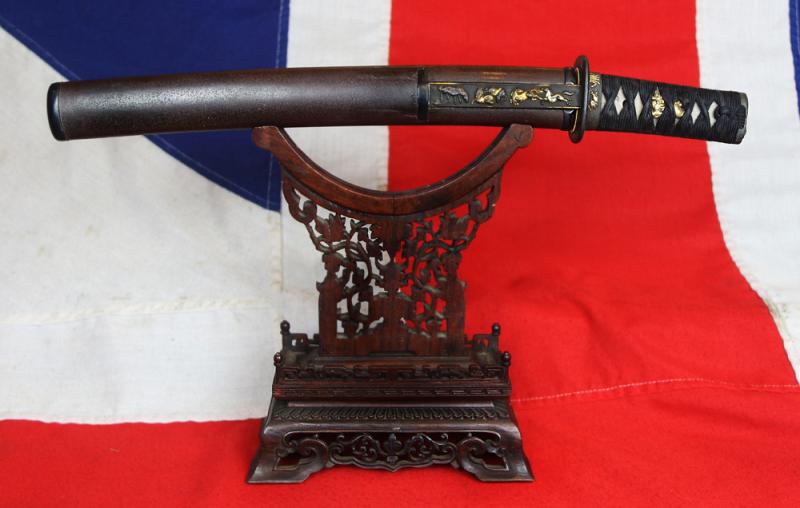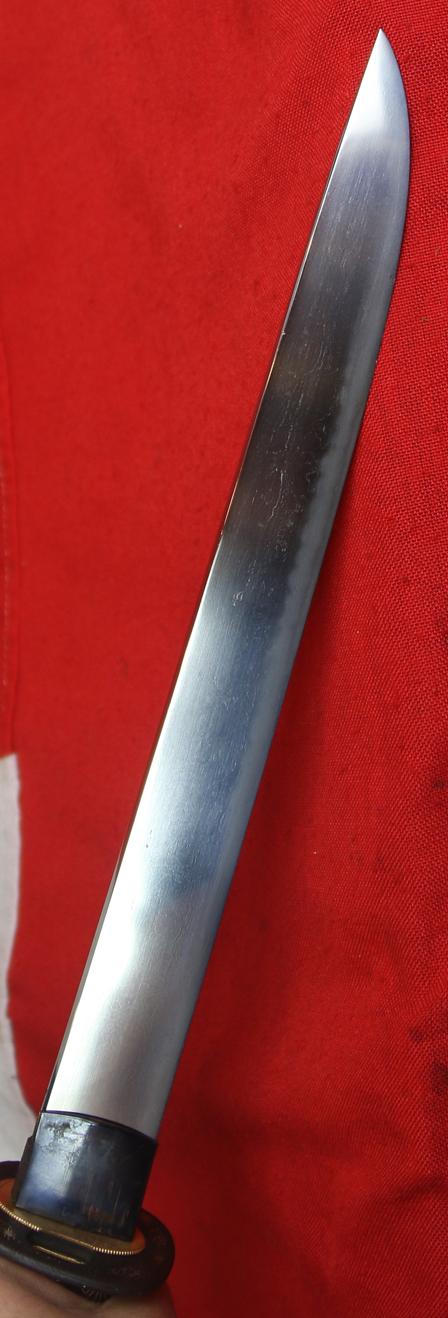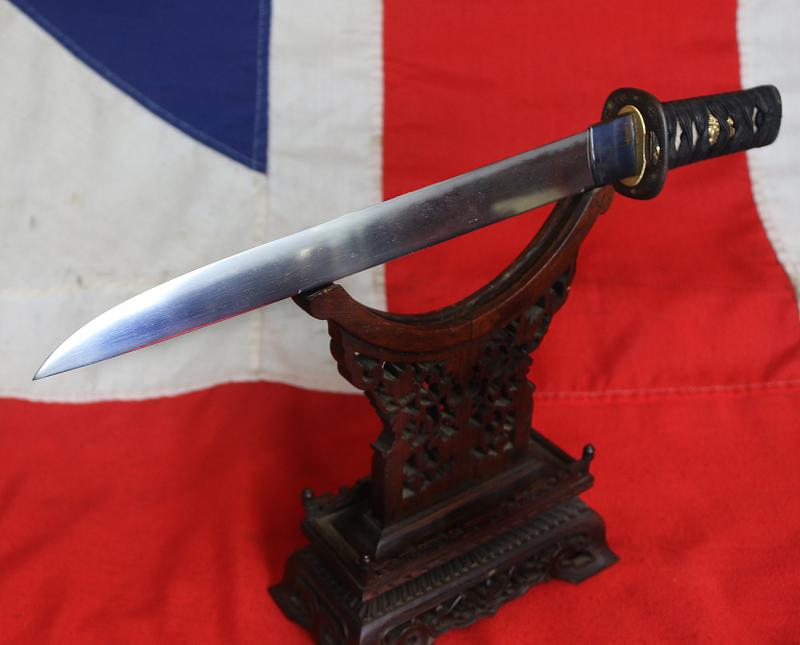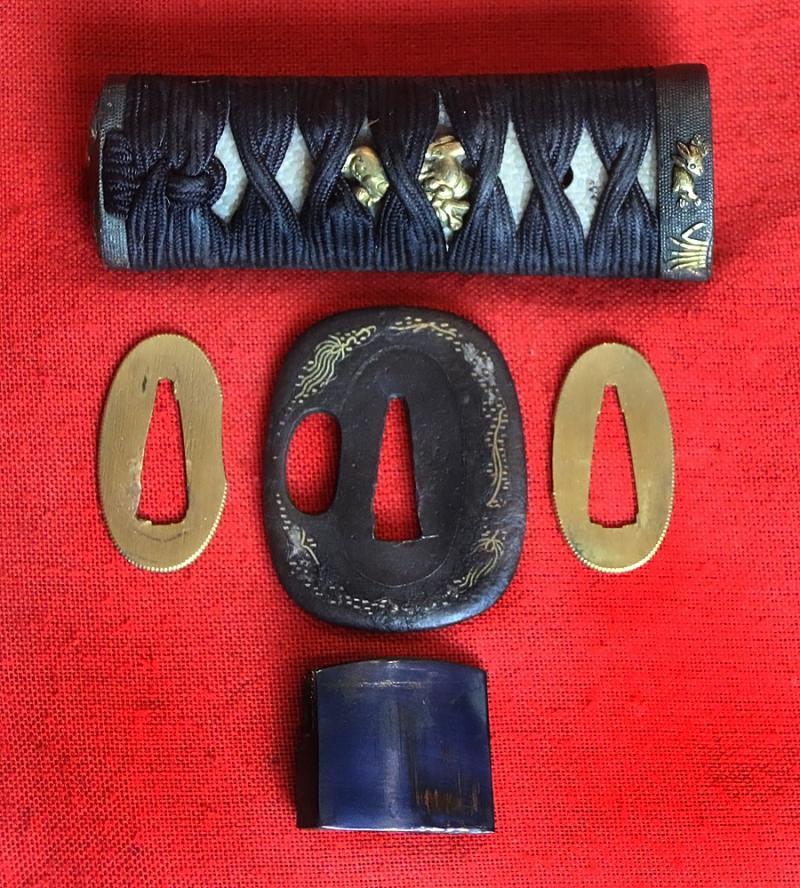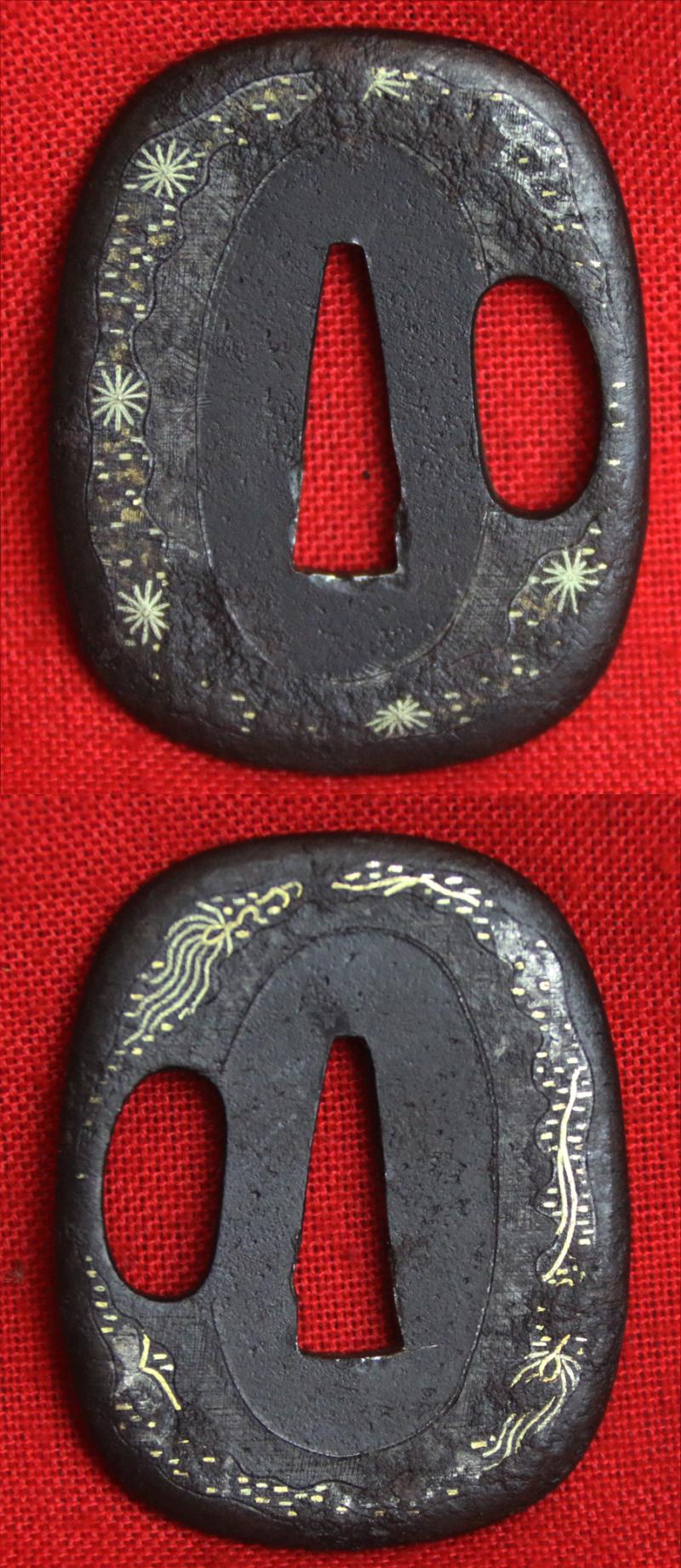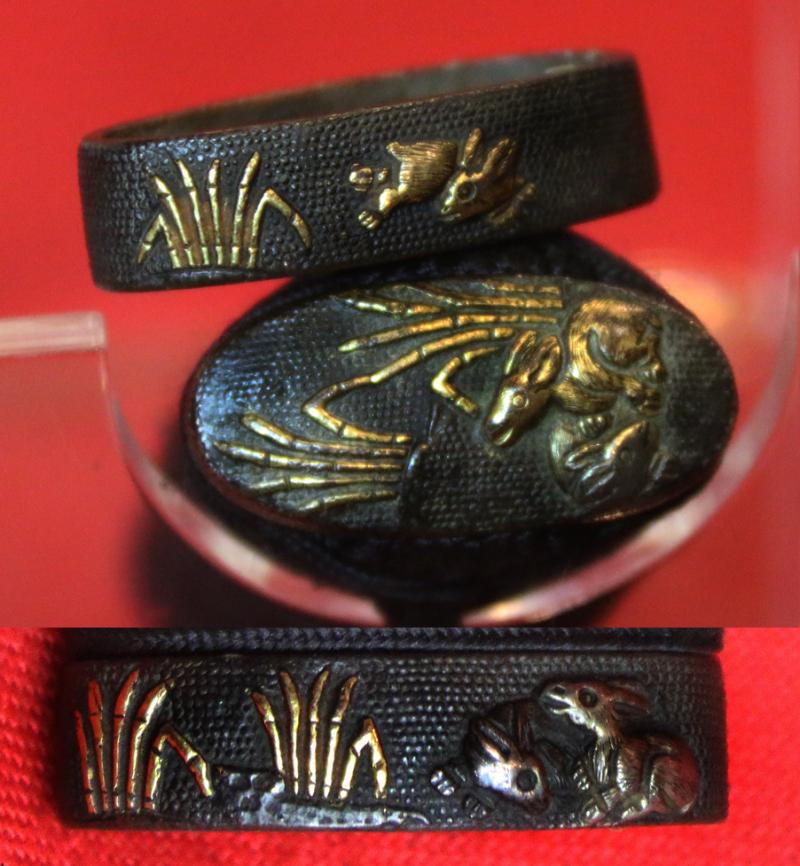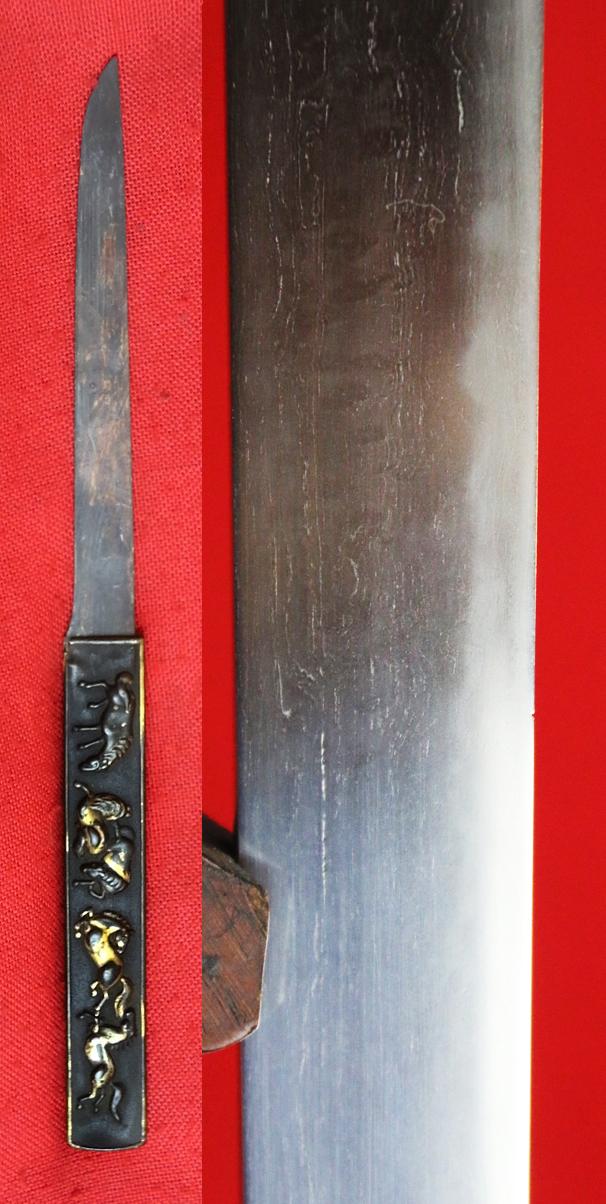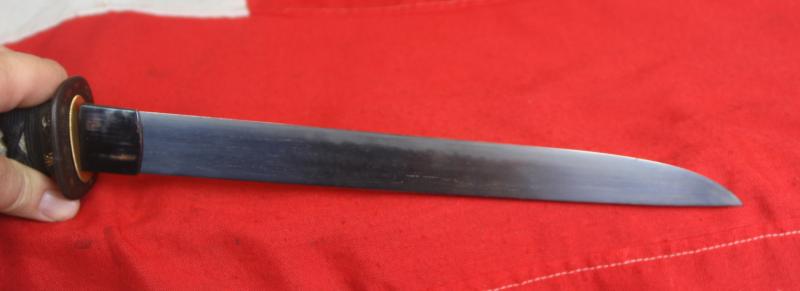A Simply Stunning Edo Period Mighty Samurai Armour and Helmet Piercer Tanto, Around 250 Years Old. An Absolute Beautiful Example of Samurai Sword Artistry & Skill
The blade is utterly amazing, with a great gunome hamon, superb grain in the hada, and powerful blade designed to pierce the strongest kabuto, iron plate war helmet, or even the strongest part of any gosuko armour, being an incredible 8 mm thick at the habaki.
Fully mounted with all its original Edo fuchi kashira decorated with takebori rabbits and reeds. Pure gold and silver rabbits on a shakudo nanako ground, with pure gold reeds. Pure gold menuki of shi shi lion dogs, under original edo black silk tsuka-itol.
It has a kozuka decorated on shakudo and gold of a herd of frolicking ponies . Original Edo period urushi lacquer ishime style, stone finish, lacquer saya with polished carved buffalo horn fittings. The only signs of age wear is on the lacquer saya, with three or four very small surface dings and slight blistering by the mid section on one side. The habaki is superb in shakudo. The tsuba is an iron tetsu oval inlaid with puer gold, with surface decoration of stylized serpent like beasts with gold stars both large and small with a pair of gold fronted seppa.
This would make a fabulous addition to any fine collection of original antique samurai weaponry or armour
Rabbits are one of the signs of the Japanese zodiac. They are considered lucky as the Japanese kanji used to write the word rabbit is similar to the kanji meaning "get rid of " or "make vanish". People believe that rabbits will make bad luck disappear! Rabbits are also known for jumping high. They can leap over nine feet! Rabbits symbolize everything going up in your life - improvement and success.
THE LANES ARMOURY, THE PREMIER HOME OF ORIGINAL AND AFFORDABLE ANCIENT ANTIQUITIES & ANTIQUE COLLECTABLES IN BRITAIN.
The Lanes Armoury, is world renown as Britain's favourite specialist collectors shop, and also a font of historical and educational information that is detailed with every single item. We detail each piece alongside its historical context, either generic or specific, for those that may wish to read, learn, or be informed, as opposed to simply acquire collectable items. We are probably one of the oldest companies of our kind in the whole of Europe and we have been established through generations, as specialists in armoury, military antiques, militaria collectables, and specialist books, since the early 1900’s, and thus we have continued to be one of the largest in the world today. The current partners were set on this path by their great grandfather, who while intrigued by historic antique arms and armour, was woefully under capitalised for his dream profession, so much so that even when starting his very small business, just after the first world war, he still kept up his original working class pre war trade as a scaffolder as his safety net in case his dreams folded. Just as well for his succeeding generations, he didn’t fail. However, true to his very old-fashioned working class ethics, every subsequent generation had to follow their own path, with no financial assistance whatsoever, with his son, grandson and great-grandsons having to make their own way, on their own skill and merits, whatever they may be.
We are also very pleased to know we are also studied and read by academics and students from hundreds of universities around the world, by those that are interested in not only British but worldwide history. Of course we are not perfect and errors can and will be made, but thanks to our viewers and visitors, errors can be corrected, and learnt from.
Our sacred principle is that every single country's history ought to be studied, and passed down, however good, or bad some of it may be. All history is knowledge, good, bad or indifferent.
Everyday we are contacted by historians that wish to make contributions to our detailed information for our pieces, and to thus add to our constant dedication to impart historical knowledge, that may be unknown to many of our millions of viewers.
As once told to us by an esteemed regular visitor to us here in our gallery, in order to view and study our Japanese edged weapons and armour gallery, and the same words that are repeated in his book;
“In these textures lies an extraordinary and unique feature of the sword - the steel itself possesses an intrinsic beauty. The Japanese sword has been appreciated as an art object since its perfection some time during the tenth century AD. Fine swords have been more highly prized than lands or riches, those of superior quality being handed down from generation to generation. In fact, many well-documented swords, whose blades are signed by their makers, survive from nearly a thousand years ago. Recognizable features of the blades of hundreds of schools of sword-making have been punctiliously recorded, and the study of the sword is a guide to the flow of Japanese history.”
Victor Harris
Curator, Assistant Keeper and then Keeper (1998-2003) of the Department of Japanese Antiquities at the British Museum. He studied from 1968-71 under Sato Kenzan, Tokyo National Museum and Society for the Preservation of Japanese Swords
Blade 12 inches long
Code: 24380
4950.00 GBP


